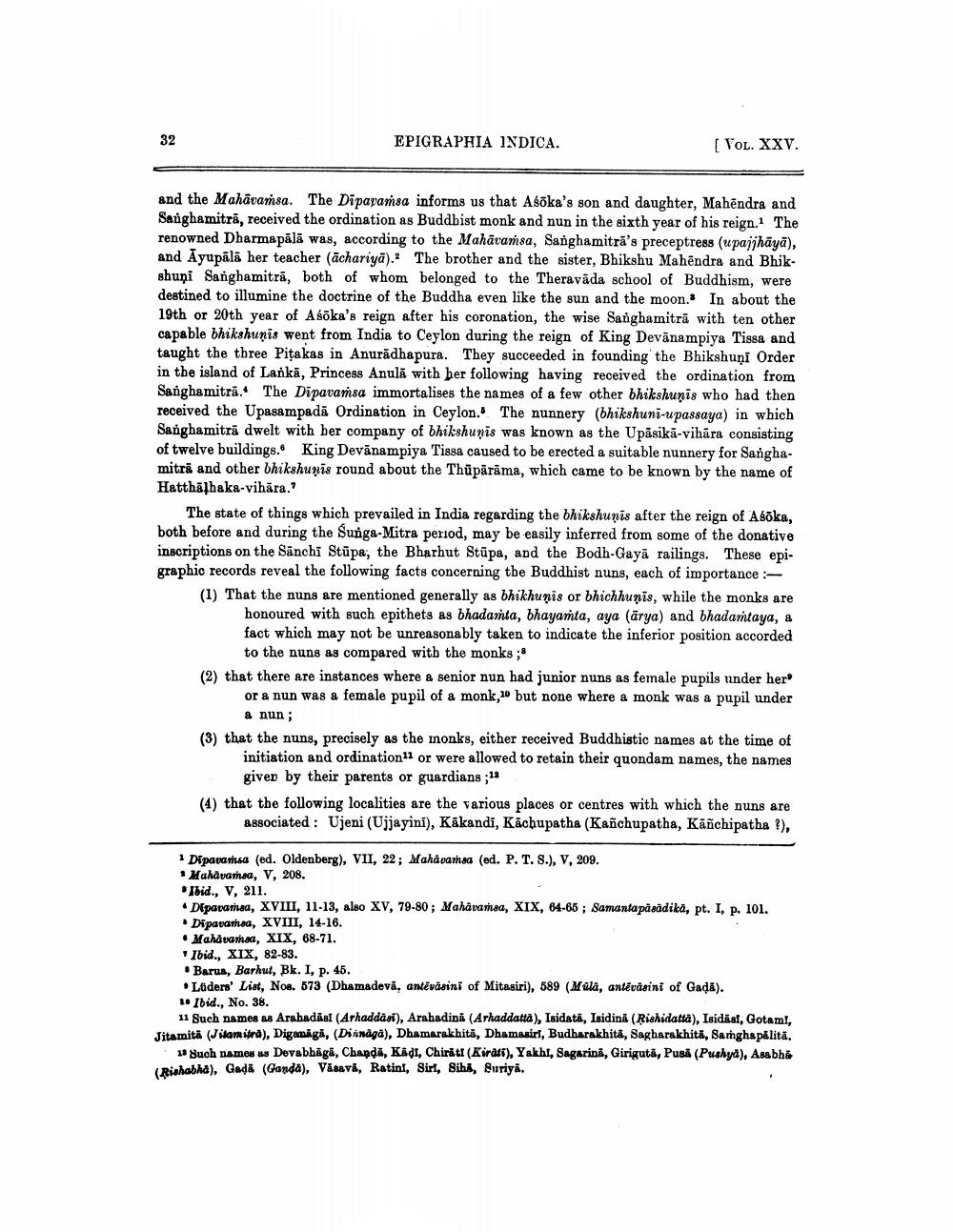________________
32
EPIGRAPHIA INDICA.
[Vol. xxv.
and the Mahavamsa. The Dipapamsa informs us that Asoka's son and daughter, Mahēndra and Sanghamitrā, received the ordination as Buddhist monk and nun in the sixth year of his reign. The renowned Dharmapālā was, according to the Mahāvaṁsa, Sanghamitrā's preceptress (upajjhāyā), and Ayupāla her teacher (achariya). The brother and the sister, Bhikshu Mahendra and Bhikshuni Sanghamitrā, both of whom belonged to the Theravāda school of Buddhism, were destined to illumine the doctrine of the Buddha even like the sun and the moon. In about the 19th or 20th year of Asoka's reign after his coronation, the wise Sanghamitrā with ten other capable bhikshunis went from India to Ceylon during the reign of King Devānampiya Tissa and taught the three Pițakas in Anuradhapura. They succeeded in founding the Bhikshuni Order in the island of Lankā, Princess Anulā with her following having received the ordination from Sanghamitrā. The Dipavaṁsa immortalises the names of a few other bhikshunis who had then received the Upasampadā Ordination in Ceylon. The nunnery (bhikshuni-upassaya) in which Sanghamitrā dwelt with her company of bhikshunis was known as the Upasikā-vihāra consisting of twelve buildings. King Devānampiya Tissa caused to be erected a suitable nunnery for Sanghamitrā and other bhikshunis round about the Thūpārăma, which came to be known by the name of Hatthälhaka-vihāra.?
The state of things which prevailed in India regarding the bhikshunis after the reign of Asöka, both before and during the Sunga-Mitra period, may be easily inferred from some of the donative inscriptions on the Sanchi Stūpa, the Bharhut Stūpa, and the Bodh-Gayā railings. These epigraphic records reveal the following facts concerning the Buddhist nuns, each of importance - (1) That the nuns are mentioned generally as bhikhunis or bhichhunis, while the monks are
honoured with such epithets as bhadamta, bhayamta, aya (ärya) and bhadamtaya, a fact which may not be unreasonably taken to indicate the inferior position accorded
to the nuns as compared with the monks ; (2) that there are instances where a senior nun had junior nuns as female pupils under her
or a nun was a female pupil of a monk, but none where a monk was a pupil under
& nun; (3) that the nuns, precisely as the monks, either received Buddhistic names at the time of
initiation and ordination'l or were allowed to retain their quondam names, the names
given by their parents or guardians ; * (4) that the following localities are the various places or centres with which the nuns are
associated : Ujeni (Ujjayini), Kakandi, Kächupatha (Kañchupatha, Kañchipatha ?),
1 Dipavarsa (ed. Oldenberg), VII, 22; Mahavamsa (ed. P. T. 8.), V, 209. • Mahavamsa, V, 208.
Ibid., v, 211. • Depavamaa, XVIII, 11-13, also XV, 79-80; Mahavamaa, XIX, 64-66 ; Samantapåsädika, pt. I, p. 101. .Dipavamaa, XVIII, 14-16.
Mahavamsa, XIX, 68-71. Ibid., XIX, 82-83. . Barua, Barhut, Bk. I, p. 45. • Lüders' List, No. 673 (Dhamadova, antëväsini of Mitasiri), 589 (Mula, antivasini of Gadā). 1. Ibid., No. 38.
11 Such names sa Arabadaal (Arhaddasi), Arabadina (Arhaddatta), Isidati, Isidina (Rishidatta), Isidäst, Gotami, Jitamita (Jilanitra), Digamaga, (Dirndga), Dhamarakhita, Dhamasirl, Budharakhita, Sagharskhita, Sanghapalita,
** Such name is Dovabhäga, Chanda, Kädi, Chiritt (Kirasi), Yakhi, Sagarini, Giriguta, Pusa (Pushya), Asabhi (Rishabha), Gada (Ganda), Visavá, Ratint, Sirt, Sihi, Suriya.




